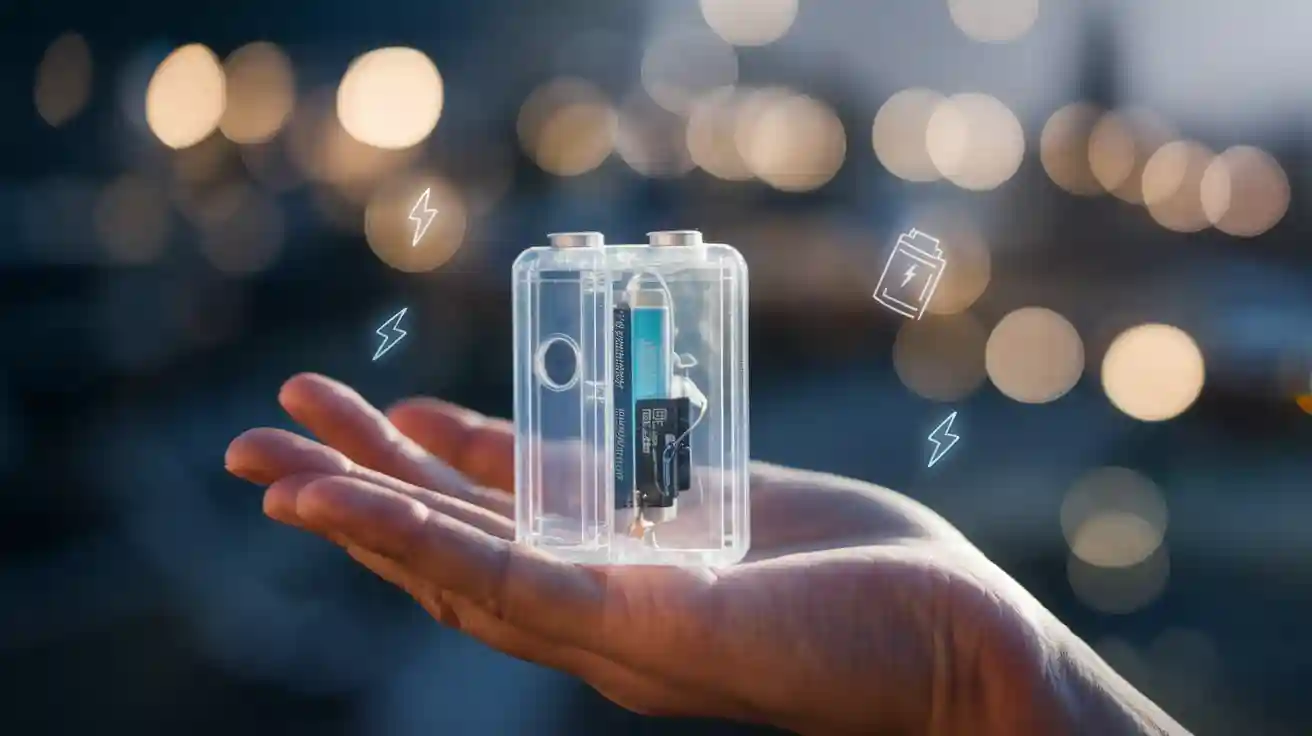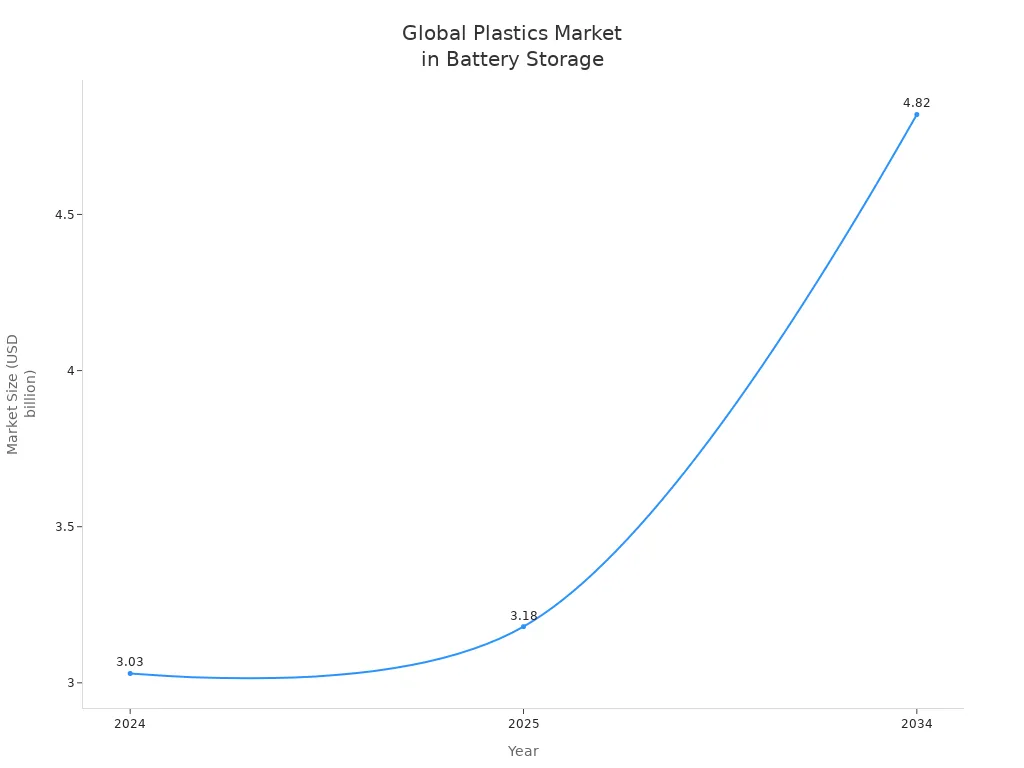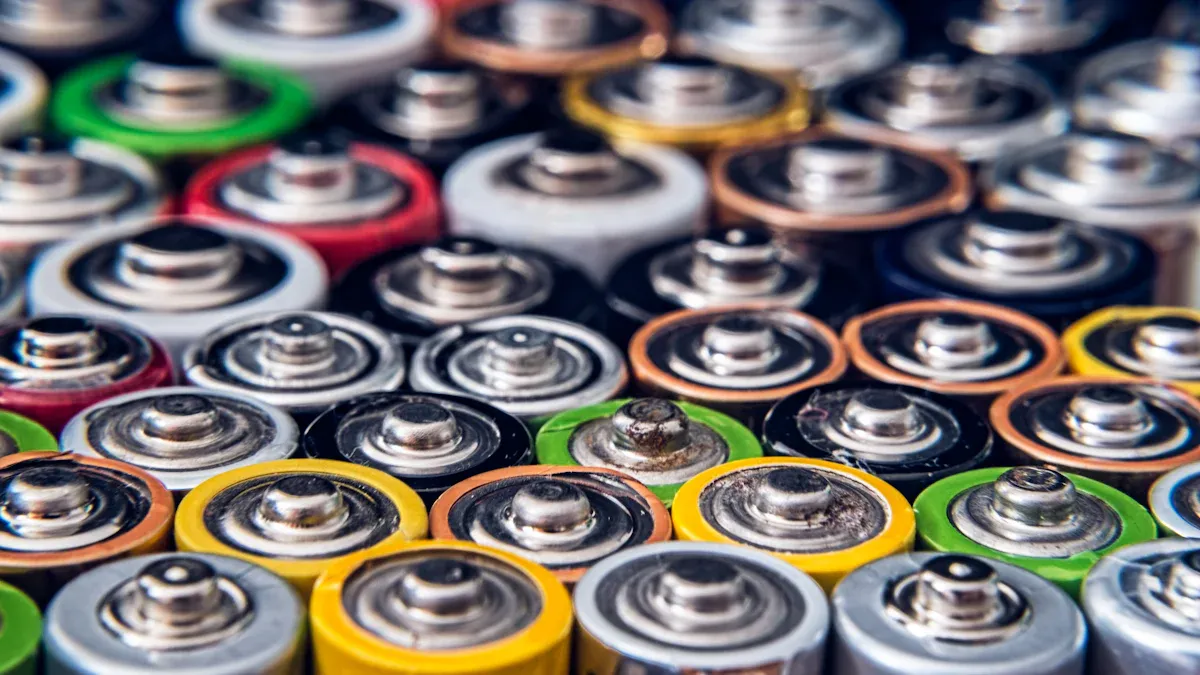
You rely on battery plastics every time you use batteries for energy storage at home or in your devices. These plastics act as insulators, separators, and housings, making batteries safer and more reliable for all kinds of energy storage solutions. Battery plastics help keep battery energy storage systems stable, lightweight, and cost-effective. As demand for energy storage grows, especially with electric vehicles and renewable energy, you see new advances in battery technology using smart, recyclable plastics.

Today, advanced polymers improve battery performance, support eco-friendly energy storage solutions, and respond to the need for sustainability in modern energy systems.

Battery Plastics Overview
Definition
You see battery plastics in almost every part of modern batteries and energy storage systems. These plastics are special materials that help build the main parts of batteries, such as insulators, separators, housings, and membranes. You find them in lithium batteries, lead-acid batteries, and many other energy storage solutions. Battery plastics keep the inside parts of batteries from touching each other, which helps prevent short circuits. You also notice that these materials make batteries lighter and easier to shape. When you look at energy storage systems, you see that battery plastics help create strong and flexible designs. They allow you to use batteries in many different ways, from small devices to large energy storage solutions for homes and businesses.
Conseil : Battery plastics are not just covers or shells. They are smart materials that help batteries store and deliver energy safely and efficiently.
Importance
You depend on battery plastics for safety, chemical stability, and better performance in energy storage. In lithium batteries, these plastics act as redox-active electrode materials. They can accept or release electrons, which helps the battery work again and again. The plastics do not dissolve in the battery’s liquid electrolyte, so they stop short circuits and make the battery last longer. You can change their chemical structure to improve how well they work and how stable they are. Battery plastics also give you mechanical flexibility, so you can have thin, bendable, or even printable batteries. This makes energy storage safer and more useful in many situations.
You also find metalized plastic current collectors in lithium batteries. These have layers that help stop short circuits if something goes wrong. They can melt or change shape under high heat, which breaks the connection and stops explosions. These collectors are light, flameproof, and cheap to make. You see them in large-scale energy storage systems because they help increase energy density and safety.
Plastics also help batteries work better. Some electrodes made from microplastics show higher capacity, even more than twice what you expect after many cycles. An amorphous carbon layer from polyethylene microplastics improves how electricity moves inside the battery. This means the battery lasts longer and works faster. You also see waste plastics like PET turned into polymer electrolytes. These give lithium batteries more strength and stop the anode from bending or breaking. PET-based electrolytes let lithium batteries run for up to 150 cycles, showing that plastics can make batteries safer and more efficient.
You use battery plastics in many energy storage solutions because they help batteries store more energy, last longer, and stay safe. They also make it possible to recycle old plastics into new battery materials, which helps the environment. When you choose energy storage systems with advanced battery plastics, you get better performance and help support a cleaner future.
Materials Used

Polypropylene and Polyethylene
You find polypropylene (PP) and polyethylene (PE) in almost every lithium battery. These materials make up the separators that keep the positive and negative sides apart. PP and PE membranes have a highly porous structure. This helps them soak up and hold the electrolyte, which lets lithium ions move easily. You get better ionic conductivity and higher performance in your batteries. These separators can handle heat up to 160°C. If the temperature gets too high, they shut down between 127°C and 165°C to stop thermal runaway. This feature keeps your lithium batteries safe.
| Property Aspect | Polypropylene (PP) | Polyethylene (PE) (especially HDPE) |
|---|---|---|
| Mechanical Properties | High resistance to fatigue, impact, heat, freezing; harder and more rigid | High strength-to-density ratio; tough, rigid, good impact and abrasion resistance |
| Chemical Resistance | Resistant to acids, organic solvents, electrolytes | Good chemical resistance, stable in cold temperatures |
| Thermal Properties | High melting point; good thermal stability | Good thermal stability; stands up well in cold temperatures |
| Electrical Properties | Good dielectric properties; excellent electrical insulation | Good electrical insulator; good tracking resistance |
| Application Relevance | Used in battery cases, electrical components due to durability and insulation | Used in battery separators and protective components for toughness and insulation |
You see these materials in lithium batteries because they offer strength, chemical resistance, and electrical insulation.
PVC and ABS
You also use PVC (polyvinyl chloride) and ABS (acrylonitrile butadiene styrene) in lithium batteries. PVC gives you good chemical resistance and electrical insulation. You find it in battery sleeves and outer covers. ABS is tough and impact-resistant. It protects the inside of lithium batteries from bumps and drops. Both materials help your batteries last longer and stay safe in different conditions.
Conductive Polymers
You can boost the performance of lithium batteries with conductive polymers. These materials, like polyaniline (PANI), PEDOT, and polypyrrole (PPy), let electrons move quickly. They help your batteries charge faster and last longer. Conductive polymers also make lithium batteries more flexible and stable. You get better cycling stability and higher capacity. Radical polymers add even more redox-active sites, which means more energy storage. These materials help your batteries stay safe and work well over many cycles.
| Polymer Type | Examples | Conduction Mechanism | Impact sur les performances de la batterie |
|---|---|---|---|
| Conjugated Polymers | Polyaniline (PANI), PEDOT, PBI, Polypyrrole (PPy) | Electron conduction via delocalized π-electrons along polymer chains | Enhanced electrical conductivity, improved charge transfer, better electrochemical kinetics, increased capacity and rate performance, mechanical flexibility, improved cycling stability |
| Radical Polymers | Poly(4-glycidyloxy-2,2,6,6-tetramethylpiperidine-1-oxyl) | Electron transfer through redox reactions of free radical groups | High density of redox-active sites, potential as electrode-active materials, improved electron conduction pathways, enhanced battery stability and safety |
| Non-redox-active Polymers | N/A | N/A | Serve as conductive additives and polymeric binders, improving mechanical integrity, flexibility, and electrode life cycle |
Advanced Polymers
You see new advanced polymers changing how lithium batteries work. Scientists blend polyethylene oxide (PEO) with charged polymers to make solid electrolytes. These materials replace flammable liquids and make lithium batteries safer. You get stable, uniform electrolytes that boost energy density. Some advanced polymers mix natural rubber with nano-carbon black, molybdenum disulfide, or carbon nanotubes. These blends make lithium batteries tougher and increase their electrical output. You also find polymers like PVDF, PAN, and redox-active polymers in lithium batteries. They give you better ionic conductivity, flexibility, and safety. These advanced materials help you build batteries that last longer, store more energy, and support recycling.
Remarque : Advanced polymers and composites help you create safer, more powerful, and more sustainable lithium batteries for the future.
Properties
Durability
You want your batteries to last a long time and work safely. Durability in battery plastics means they can handle tough conditions without breaking down. Here are some reasons why durability matters for batteries:
- Durable plastics resist strong chemicals inside batteries, so they do not wear out quickly.
- These plastics stay strong in hot or cold temperatures, keeping batteries safe.
- Good insulation from durable plastics stops short circuits.
- Low permeability keeps the battery’s liquid and gases inside, so nothing leaks out.
- Strong plastics protect batteries from bumps and drops.
- Non-reactive plastics do not mix with battery chemicals, so the battery stays pure.
When you use durable plastics, your batteries stay stable, safe, and efficient for a long time.
Chemical Resistance
Batteries need plastics that can stand up to harsh chemicals. You find that many plastics, like ABS, Polypropylene, and PVC, have high chemical resistance. The Cole-Parmer Chemical Compatibility Database shows how these plastics react to different chemicals. For example, HDPE and PTFE get top ratings for resisting acids and water. This means your batteries can handle tough environments without the plastics breaking down. When you choose batteries with the right plastics, you get longer life and better safety.
| Plastic Type | Chemical Resistance Rating | Common Use in Batteries |
|---|---|---|
| HDPE | A (Excellent) | Casings, separators |
| PTFE | A (Excellent) | Membranes, gaskets |
| ABS | B-D (Varies) | Housings, covers |
| PVC | A (Excellent) | Sleeves, insulation |
Insulation
Insulation is a key property in battery plastics. You need insulation to stop electricity from jumping between parts inside batteries. Good insulation keeps batteries from short-circuiting or catching fire. Many plastics use special flame-retardant groups that do not release harmful chemicals. This makes batteries safer and helps them last longer. You also find that insulation materials prevent electrical arcs and thermal runaway, which are big risks in high-voltage batteries. When you use batteries with strong insulation, you get better safety and performance.
- Insulation stops electrical failures.
- It prevents thermal events in batteries.
- Flexible insulation acts as a barrier to heat and pressure.
Flexibility
Flexibility lets batteries fit into many shapes and devices. You see flexible plastics in batteries for wearables, smart clothing, and curved electronics. Flexible materials like carbon nanotubes and conducting polymers help batteries bend without breaking. Special designs, such as helical or kirigami patterns, make batteries even more stretchable. Flexibility also helps batteries keep working after bending or twisting. When you use flexible batteries, you can power new devices that need to move or change shape.
| Aspect | Benefit for Batteries |
|---|---|
| Flexible materials | Fit curved surfaces, resist fatigue |
| Flexible structures | Improve stretchability, handle mechanical stress |
| Application scenarios | Wearables, robotics, smart textiles, electronic skins |
Tip: Flexible batteries open up new ways to power devices that need to bend, stretch, or twist.
Applications in Batteries
Casings and Housings
You see plastics used in casings and housings for many batteries. These parts protect the inside of energy storage devices from damage, moisture, and chemicals. Plastic casings are lightweight, which helps you carry portable energy storage devices more easily. You get design flexibility, so batteries can fit into many shapes and sizes. PVC and other plastics act as electrical insulators, keeping your battery energy storage systems safe from short circuits. Injection-molded plastic enclosures also help keep batteries stable and durable. You find these casings in advanced lithium-ion batteries and other energy storage systems.
Separators and Membranes
Plastics play a key role in separators and membranes inside batteries. You find thin plastic membranes, often made from polyethylene or polypropylene, between the anode and cathode. These separators stop the electrodes from touching, which prevents short circuits and keeps your energy storage safe. At the same time, they let ions move through, so your batteries can store and deliver energy. In advanced lithium-ion batteries, separators improve ion transport and battery performance. Some separators have special coatings or multilayer designs for extra safety and longer life.
Binders and Electrodes
You use plastics as binders in battery electrodes. Binders hold the active materials and conductive agents together, making sure the electrodes stay strong during charging and discharging. They help control the thickness and uniformity of the electrode layer, which improves energy storage and battery performance. In advanced lithium-ion batteries, binders like PVDF give you flexibility and stability. Some new binders also help with conductivity and eco-friendliness. Plastics in electrodes and separators help your batteries last longer and work better.
Supercapacitors
Supercapacitors are special energy storage devices that use plastics in many ways. You find flexible packaging made from aluminum-plastic film, which helps with heat dissipation and allows for high power. Inside, plastics like polyethylene and polypropylene are used as separators and in electrodes. Scientists recycle plastics to make carbon nanofibers and nanotubes, which serve as high-performance electrodes. Conductive polymers such as PEDOT improve the charge storage and cycle life of supercapacitors. These advances help supercapacitors store more energy and last for many cycles.
Note: Plastics help you get safer, more efficient, and longer-lasting energy storage in batteries and supercapacitors. You see their impact in advanced lithium-ion batteries and many other energy storage applications.
Innovations in Battery Plastics

Conductive Polymers
You see major innovation in energy storage with conductive polymers. These special plastics let electrons move easily because of their unique structure. You find materials like Polyaniline (PANI), Polypyrrole (PPy), Polythiophene (PTh), and PEDOT in many energy storage devices. These polymers work as electrodes and electrolytes, making batteries and supercapacitors more flexible and powerful. You can use them in wearable electronics and flexible devices. Scientists use new methods like chemical and electrochemical polymerization to make these materials. You get high discharge capacity, strong cycling stability, and better power density. Some trends focus on making these polymers last longer and stay stable, even after many uses. You also see new device designs and production methods, such as roll-to-roll processing and 3D printing, which help bring these innovations to large-scale renewable energy storage.
- Conductive polymers improve electrical conductivity and flexibility.
- You find them in advanced energy storage and renewable energy storage systems.
- These materials support trends in flexible and wearable energy storage.
Note: Conductive polymers help you build lighter, more efficient, and flexible energy storage devices.
Sustainable Materials
You notice a big shift toward sustainable materials in battery plastics. Many companies now use recycled plastics and biodegradable parts in energy storage systems. These materials come from renewable sources and break down naturally, which helps reduce waste and pollution. Using recycled plastics lowers the need for new, fossil-fuel-based materials. You help cut the carbon footprint and save natural resources. Some new trends include using household waste as additives, which can lower carbon emissions by up to 30%. You also see hemp-based products and soft, biocompatible materials made from peptides and plastics. These innovations make energy storage safer for the environment and support the circular economy.
- Sustainable materials reduce waste and pollution.
- You support energy storage trends that focus on eco-friendly solutions.
- These innovations help conserve resources and promote battery recycling.
Recycling
You play a key role in the recycling of battery plastics. Current methods include mechanical disassembly, which can be hard and risky because of hazardous materials. New trends use automation and AI to make recycling safer and faster. You see three main recycling techniques: pyrometallurgy, hydrometallurgy, and direct recycling. Each method has its own challenges, like dealing with complex battery designs and making sure recovered materials are pure. Plastics in battery packs are recyclable, but most focus goes to metals. You also see efforts to reuse batteries in second-life energy storage applications before recycling. This helps reduce waste and supports the growth of renewable energy storage.
Tip: Battery recycling and reuse help you get the most out of energy storage systems and protect the environment.
Solar Energy Storage
You find exciting innovation in solar energy storage with new thermoplastic compounds. Engineers design these plastics to replace heavy metal parts in solar batteries. You get lighter, corrosion-resistant, and more cost-effective energy storage solutions. These thermoplastics improve the reliability and efficiency of solar energy storage systems. For example, some new compounds cut weight by up to 70% and lower costs by 40%. You help solar farms store extra energy during the day and release it when needed. These trends make large-scale renewable energy storage more practical and affordable.
| Fonctionnalité | Traditional Metal | Thermoplastic Compound |
|---|---|---|
| Weight | Heavy | Light |
| Corrosion Resistance | Faible | Haut |
| Coût | Haut | Faible |
| Energy Efficiency | Standard | Improved |
Innovation in thermoplastics lets you build better solar energy storage systems for the future.
Future of Battery Energy Storage
Research Trends
You see many new research trends shaping the future of battery plastics in energy storage. Scientists focus on making energy storage systems safer, greener, and easier to recycle. You can look at the table below to understand the main research trends in battery plastics for next-generation energy storage:
| Research Trend / Focus Area | Description | Significance |
|---|---|---|
| Sustainability challenges of PVDF binders | PVDF binders release toxic compounds during recycling. | You need safer alternatives for better energy storage recycling. |
| Replacement of PVDF in LFP cathodes | New binders replace PVDF in lithium iron phosphate batteries. | You improve recyclability in a large part of energy storage. |
| Challenges with nickel-containing cathodes | PVDF is still needed for nickel cathodes. | You need new binders for these energy storage systems. |
| Recycling process improvements | Better ways to separate battery parts and remove binders. | You lower costs and help the environment in energy storage. |
| Co-design of battery packaging and production | Design batteries for easier recycling and new chemistries. | You support future energy storage trends and circular economy. |
These research trends help you build better energy storage systems and support the future of energy storage.
Durabilité
You notice that sustainability shapes the future of battery plastics and energy storage trends. Many companies and scientists work to make energy storage safer and more eco-friendly. Here are some important sustainability trends:
- You see a push for safer, non-toxic, and recyclable materials in energy storage.
- The EU Batteries Regulation requires lower carbon footprints and more recycling in energy storage systems.
- Some batteries, like Enerpoly’s zinc-ion, use local, non-flammable, and recyclable materials for energy storage.
- You find new recycling methods and second-life uses for batteries in energy storage trends.
- Companies focus on responsible sourcing and design for energy storage.
These sustainability trends help you protect the environment and support the growth of energy storage.
Industry Challenges
You face several challenges as you look to the future of energy storage. Many energy storage systems still use plastics that are hard to recycle or may harm the environment. You need to find new materials that work well and are safe for energy storage. Some energy storage trends show that recycling battery plastics is complex and costly. You also see that new energy storage chemistries, like solid-state batteries, need different plastics and designs. You must balance safety, cost, and performance in energy storage systems. As you follow energy storage trends, you see that solving these challenges will help you build better and cleaner energy storage for everyone.
You see plastics play a vital role in batteries and energy storage by providing fire protection, safety, and durability. Advanced materials like conductive polymers make batteries safer and more reliable for grid and renewable energy storage. Ongoing research improves recycling and sustainability, helping you reduce waste and lower emissions. The plastics industry develops new solutions for energy storage, including upcycling common plastics into energy-storage materials. As demand for energy storage grows, you can expect plastics to support safer, greener, and more efficient batteries for the future.
- 🔋 Plastics help you meet safety standards and support innovation in energy storage.
- 🌱 Sustainable practices and advanced recycling shape the future of batteries and energy.
FAQ
What are battery plastics and why do you need them?
You use battery plastics to make batteries safer and more efficient. These plastics act as insulators, separators, and casings. They help you prevent short circuits and protect the battery from damage. Battery technology relies on these materials for better performance.
How do plastics improve battery safety?
You get better safety because plastics resist heat and chemicals. They stop the battery from leaking or catching fire. Some plastics melt at high temperatures and break the circuit. This feature helps you avoid accidents in large-scale renewable energy storage systems.
Can you recycle battery plastics?
Yes, you can recycle many battery plastics. You find recycling programs that collect and process used batteries. Some companies turn old plastics into new battery parts. This process supports cleaner battery technology and helps you reduce waste.
Which plastics work best for battery technology?
You often use polypropylene, polyethylene, PVC, and ABS in batteries. These plastics give you strength, chemical resistance, and insulation. Advanced battery technology also uses special polymers for better flexibility and energy storage.
How do plastics help large-scale renewable energy storage?
You see plastics make batteries lighter and more durable. This helps you build bigger energy storage systems for solar and wind power. Plastics also lower costs and improve safety in large-scale renewable energy storage projects.

